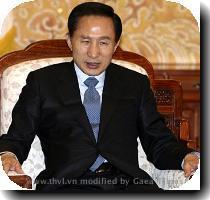SKorean president orders military on alert after official says NKorean mine may have sunk ship
By Jean H. Lee, APTuesday, March 30, 2010
SKorean president orders military on alert
SEOUL, South Korea — South Korea’s president ordered the military on alert Tuesday for any moves by rival North Korea after the defense minister said last week’s explosion and sinking of a South Korean ship may have been caused by a North Korean mine.
The blast ripped the 1,200-ton ship apart last Friday night during a routine patrol mission near Baengnyeong Island, along the tense maritime border west of the Korean peninsula. Fifty-eight crew members, including the captain, were plucked to safety; 46 are missing, with dim prospects for finding any further survivors.
Divers geared up to break into the ship Tuesday, Rear Adm. Lee Ki-sik of the Joint Chiefs of Staff told reporters. He said there were no signs of life inside.
Military officials say the exact cause of the explosion remains unclear, and U.S. and South Korean officials said there was no outward indication of North Korean involvement.
However, Defense Minister Kim Tae-young told lawmakers Monday that a floating mine dispatched from North Korea was one of several scenarios for the disaster.
“North Korea may have intentionally floated underwater mines to inflict damage on us,” Kim said.
North Korean suicide squads known as “human torpedoes” may be behind the explosion, the Chosun Ilbo newspaper said in a report Tuesday, citing unidentified high-ranking defectors from the North.
Suicide squads operate semi-submersible vessels equipped to carry two bombers and either two torpedoes or floating mines, the paper said, citing a North Korean sailor-turned-defector.
“Acoustic mines” carried by small submarines crawling along at speeds of less than 1.2 mph (2 kph), too slow to register on South Korean sonar radars, are considered particularly effective, the paper cited another defector who served in North Korean intelligence as saying.
Defense Ministry spokesman Won Tae-jae said no possibility was being ruled out but said the ship must be salvaged before any cause is confirmed.
“Everyone’s imagination has been running wild, posing all sorts of possibilities,” he said. “But we can’t say yes or no to any of them.”
The two Koreas remain in a state of war because their three-year conflict ended in a truce, not a peace treaty, in 1953. North Korea disputes the sea border drawn by the United Nations in 1953, and the western waters near the spot where the Cheonan went down have been the site of three bloody skirmishes between North and South.
Pyongyang’s state media have made no mention of the ship.
“Since the sinking took place at the front line, the military should thoroughly prepare for any move by North Korea,” President Lee Myung-bak told his Cabinet, according to his spokesman, Park Sun-kyoo. “I want the military to maintain its readiness.”
The Joint Chiefs of Staff said the cause of the blast may remain unclear until the ship is salvaged after the rescue operation is over.
The defense minister said the ship may have struck a mine left over from the war or deliberately dispatched from the North. Many of the 3,000 Soviet-made naval mines North Korea planted in the waters off both coasts during the war were removed, but not all. Kim noted a North Korean mine was discovered as recently as 1984.
He insisted there were no South Korean mines off the west coast, and ruled out a torpedo attack from North Korea, which would have been spotted by radar.
Officials have also said an internal malfunction may be to blame. The 1,200-ton Cheonan is designed to carry weapons, and was involved in a previous skirmish with North Korea.
Coast guard footage aired Tuesday by cable network YTN showed men in rubber boats being brought on board to safety, blue searchlights scanning the rough Yellow Sea waters. Crewmembers are seen on the quickly tilting deck of the ship’s front end while the rear is already underwater.
Rough waves prevented military divers from accessing the wreckage until Monday, officials said. Divers, aided by a team from four U.S. Navy ships in the region, rapped on the stern with hammers Monday afternoon but got no response, they said.
Aware that the crewmen had only enough oxygen in their watertight cabins to last until Monday evening, divers pumped oxygen into the ship through cracks in the stern, Rear Adm. Lee said.
Diving teams went down twice early Tuesday and planned two more attempts, Defense Ministry spokesman Won Tae-jae said.
“The fate of the 46 young soldiers defending our territory in the border area is still unknown,” President Lee said. “I cannot describe how regrettable this is. Let’s not give up hope until the last moment.”
Anguished relatives waited for news at a naval base in Pyeongtaek, south of Seoul, some pounding their chests with grief, others shouting their displeasure at the slow pace of the rescue.
Associated Press writers Hyung-jin Kim and Sangwon Yoon in Seoul, and Eric Talmadge in Tokyo contributed to this report.



